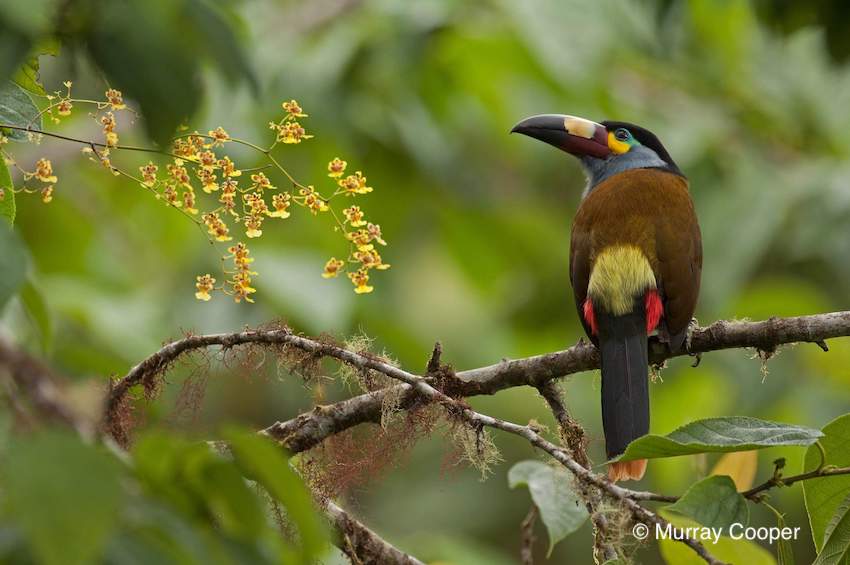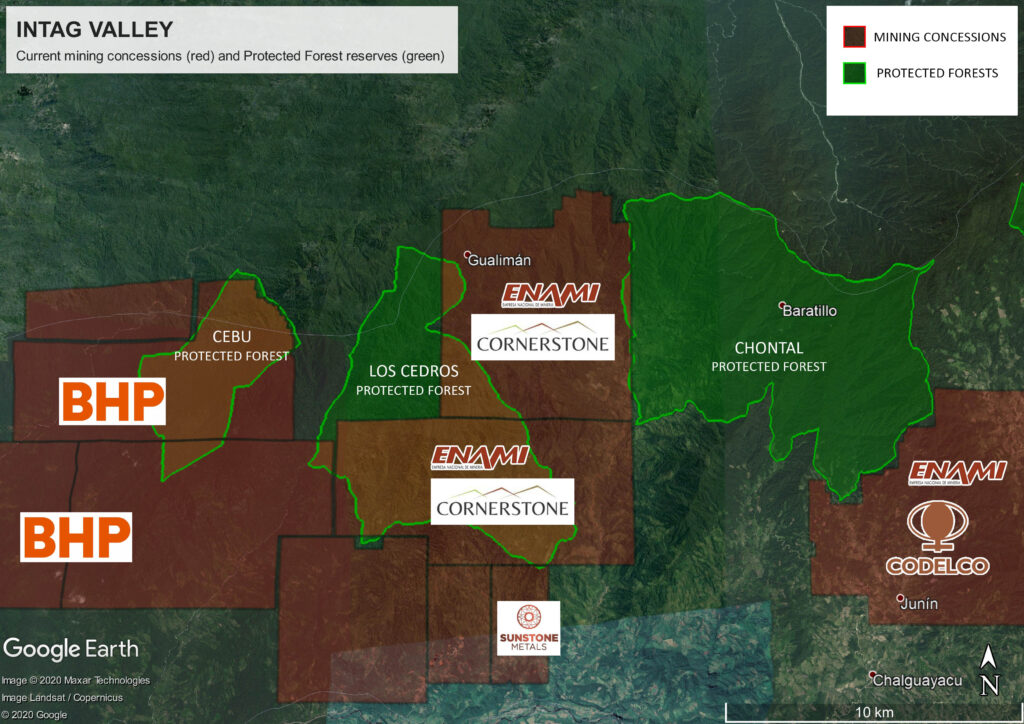A forest reserve in one of the world’s most biodiverse regions, originally set up with Australian Government support and home to over 200 species at risk of extinction, has been scheduled for a landmark legal case. In a precedent-setting move, the Constitutional Court of Ecuador has announced it will take on the case of the Los Cedros Protected Forest, which is threatened by grand-scale copper and gold mining, by using unique Rights of Nature laws enshrined in the constitution.
Edgar Merlo, who heads the legal team for Los Cedros, says: “The [Constitutional] Court’s ruling in this case would be a first in Ecuador: on the Rights of Nature, the right to prior consultation of communities, and the right to legal certainty, since concessions were granted without respecting the declaration of protective forests. The final judgement by the Constitutional Court in this case could change the legal focus in Ecuador, South America, and the entire world on the Rights of Nature and the rights of local communities, so that mining concessions are not granted in Protected Forests.”
One of the UK’s leading environmentalists, Jonathon Porritt echoed this view: “Ecuador was the first nation to include the Rights of Nature in its constitution,” he said. “It could now become the first nation to protect large swathes of biodiversity, based upon this constitutional innovation. This would set an invaluable precedent worldwide.”

Los Cedros Biological Reserve in north-western Ecuador was established in 1988 with the help of a grant from the Australian Government’s Development Assistance Bureau and the support of Australian not-for-profit organisation the Rainforest Information Centre.
Los Cedros is one of the most biologically diverse habitats in the world, with more than 4,800 hectares of primary cloud forest, and it safeguards the headwaters of four important watersheds. It protects over 200 species with high extinction risk, five of which are regarded as critically endangered by the Ecuadorian government. (see Roy et al. 2018, iNaturalist, and the Los Cedros website for more information.)
“The remoteness and high-quality of the habitat explain why there are six species of cats and three species of primate, including some of the last critically endangered brown-headed spider monkeys in the world, as well as the endangered Andean spectacled bear. New species are also being discovered every year,” explained Dr Mika Peck from Sussex University.
“This biodiversity was recognised when the Constitutional Court specifically cited the importance of Los Cedros in preserving the last populations of the spider monkey and the Andean spectacled bear which is in danger of extinction,” says John Seed, founder of the Rainforest Information Centre.
José DeCoux, the manager of Los Cedros says: “Mining in Protected Forests is a violation of the legal status of declared Protected Areas, the collective rights of indigenous peoples, the Rights of Nature, and the right of communities to prior consultation before potential environmental damages.”

In 2017, the Ecuadorian government announced new concessions for mining exploration on over 2.9m hectares (6.17m acres) of land, a roughly 300% increase. Many of these exploratory concessions are in previously protected forests and indigenous territories. Mining exploration is also occurring in headwater ecosystems and biodiversity hotspots of global importance like Los Credos, and appears to be in violation of Ecuadorian law and international treaties.
“More than 30% of Protected Forests have been under imminent threat from mining since 2017, when a policy change within the Ecuadorian government allowed these protected lands to be included in mining concessions,” explained Paul Gilding, former Executive Director of Greenpeace Australia and Greenpeace International.
As part of this rapid mining expansion, BHP and Canadian mining company Cornerstone Capital Resources were given mining permits in collaboration with the Ecuadorian state mining company, ENAMI.
“The permit for mining was given despite the Ministry of Environment’s own publication citing Los Cedros in its ‘Areas of Priority for the Conservation of Biodiversity in Ecuador’,” says John Seed.
The Los Cedros Protected Forest authorities won their case for an Action of Protection in the Provincial Court of Imbabura in June 2019, which stripped the mining companies of their operating permits. The government, working alongside the mining companies, subsequently appealed against the decision.
Meanwhile, the mining company Cornerstone Capital Resources continued exploration within the protected area in direct contravention of the court order, despite overwhelming opposition in the region, and without the appropriate permits.
“This case expresses the current conflict between the Ecuadorian government and its intention to open the country’s untapped oil and mineral reserves to foreign investment and the long-held public sentiment in Ecuador against extractionist economic development,” says John Seed.
“The case will help determine the balance between short-term economic gains through mining development and the slower — but generally more sustainable — economic development that accompanies long-term biodiversity conservation,” explained John Seed.
“This case has implications not just for Los Cedros, but for all 186 Protected Forests in Ecuador, totalling some 2.4m hectares,” said Dr Bitty Roy, Professor of Biology at the University of Oregon and one of a number of scientists for whom Los Cedros is a research base.
Globally, this is the first case where constitutional protections for nature will be evoked at a national level to protect an ecosystem from large-scale mining. Ecuador remains the only country in the world to have enshrined these rights in its Constitution. It is also a country that has recently attracted a massive amount of interest from transnational mining companies, who see vast potential in its mineral wealth, particularly copper and gold.
Australia is Ecuador’s biggest investor, with companies like SolGold, BHP, Newcrest, Hancock Prospecting, Fortescue Metals, Titan and Tempus Resources pouring millions into copper and gold exploration.
Around 750,000 hectares of legally Protected Forests across the country are currently covered by mining exploration concessions. Australian mining companies stand to be impacted by any positive ruling on the case, with at least 67 concessions covering, in whole or part, Indigenous territories or Protected Forests.
Aussie miner SolGold would be most impacted by the ruling, with 19 concessions covering Protected Forests and 18 covering Indigenous territories.
Full media release here.
- Full 30 minute wildlife documentary about Los Cedros here
- Los Cedros homepage: org
- To see some of the species that call Los Cedros home, visit iNaturalist: https://www.inaturalist.org/observations?place_id=124456&subview=grid
- Or eBird: https://ebird.org/hotspot/L1481360
- For more information and to donate, please visit the crowdfunding campaign here: https://www.fundmyplanet.org/campaign/11/save-ecuadors-forests-from-mining
- Roy, Bitty A., Martin Zorrilla, Lorena Endara, Dan C. Thomas, Roo Vandegrift, Jesse M. Rubenstein, Tobias Policha, Blanca Rios-Touma, and Morley Read. (2018). New mining concessions could severely decrease biodiversity and ecosystem services in Ecuador. Tropical Conservation Science. 11: 1940082918780427.
https://journals.sagepub.com/doi/full/10.1177/ 19400829187804 - Magdaleno, Johnny. (Nov 2018). In Ecuador, landmark court cases challenge mining projects. Thomson Reuters Foundation. https://www.reuters.com/article/us-ecuador-landrights-mining/ in-ecuador-landmark-court-cases-challenge-mining-projects-idUSKCN1NA222
- Basantes, Ana Cristina. (May 2020). Mining company pressing to enter Ecuador’s Los Cedros Protected Forest. Mongabay. https://news.mongabay.com/2020/05/mining-company-pressing- to-enter-ecuadors-los-cedros-protected-forest/
